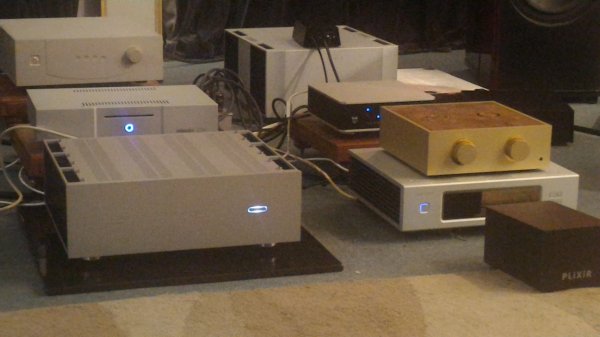well i got time to do my test of the uRendu in MPD and NAA mode.
I wanted to compared MPD with NAA mode since some have reported improvements by moving the renderer from the uRendu and having the uRendu be only the NAA (less processing clearly). i had no preconceived ideas on how this would turn out but spent a few days installing hqplayer desktop on my main linux machine and verifying i could get sound out. i uninstalled all modes except NAA and MPD from the uRendu. BubbleUPNP was used as the control point for MPD and hqplayer desktop for NAA mode. (note: this required me to run/limp between adjacent rooms to start the hqplayer which my recently repaired knee/meniscus did NOT appreciate..............the obsessive things we do for better sound). another variable was using the sonore battery supply instead of the sms-100's wall wart. lastly, i had audiobuddy AK over to give me a 2nd opinion. he and i have been in pretty good agreement on changes to sound and he has been very helpful as i optimized cables/speakers/DAC over the past few years.
The setup:
D1-Dual DAC to Pass Aleph pre-amp to Ayon monoblocks to Nola Metro-Grand speakers, cabling via Synergistic Research.
Music in WAV format on netgear NAS running minimserver, optical from netgear 48 port switch, converted back to cat8 cable to uRendu with adapter directly into USB input of DAC.
Music: Alison Krauss (Forget About It), Paul Simon (Diamonds on the Soles of her Shoes), Jennifer Warnes (Runaway Horse), Duke Ellington Orchestra (Concerto for Cootie, Great Paris concert), Keith Jarret Trio (Things Ain't What They Used to Be), Caroline No (Beach Boys, mono), Mahler's First (Bernstein), Ramirez (Missa Criola), What's New in Baltimore (Frank Zappa live)
first we compared the wallwart power to the sonore battery power. there may have been a small difference but it wasn't night and day so we left the battery in and went on to the MPD/NAA comparison.
this blew us away. the NAA was so much better than MPD mode, streaming from the same NAS that is was drop dead simple, game over. except for one song (i'll get back to that), it was no contest. the soundstage was huge, the bass was fuller, the detail was much more apparent though not in your face, but most important to me (and i find this almost always the key indicator) was the ability to hear deep into the decay of notes. on the jennifer warnes, the decay of each bass note went on forever and segued into the next lyric or bass note, each of her lyrics ended wth a slow decay of her voice/breath that was "in the room". the keith jarret had much more bass, exceptional drum impact and the sound of his piano was night and day with NAA having overtones and complexities to his playing that made us want to turn off MPD mode after 5-10 seconds. the soundstage was huge on missa criolla and the paul simon intro with ladysmith black mambazo's vocals.
the only song where it wasn't a slam dunk was the alison krauss track. NAA had more detail and separation, but it wasn't as blindingly better. AK felt he could like either.
note that I had hqplayer set to do nothing fancy, no upsampling, no dither, just render the native resolution audio so the uRendu NAA could pass data to the DAC. i have never tested any of those hqplayer options such as upsampling or DSD and may not (I don't think i want to go down a rabbit hole with that many variables).
p.s. by the way, everyone should try before buying the hqplayer (as Miska suggests) to see if this is your cup of tea or not. i am running the desktop linux version trial which plays only for 30 minutes, but that (and a few shut downs and startups) gave me enough to convince me there is something very special here.
So, getting back to the earlier discussion of the totalDAC server. I have tremendous respect for Vincent and his updated server may in fact be better than the uRendu. I have not had the pleasure of hearing it myself but I am a believer in Vincent's work. However, if you have compared the uRendu in MPD mode, my experience suggests you have not heard the uRendu at anywhere near its capabilities. I have no basis for an opinion on which is superior but you really should try NAA mode before concluding that the uRendu is outclassed (since NAA easily outclasses MPD mode).
Of course, remember that synergy is god, every system is different and your mileage may vary.













